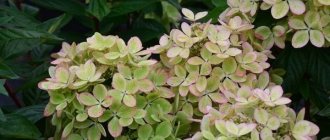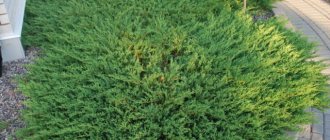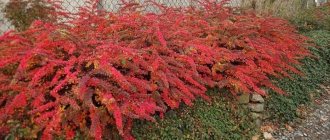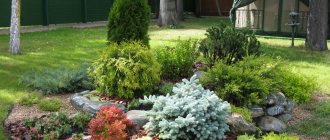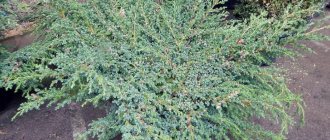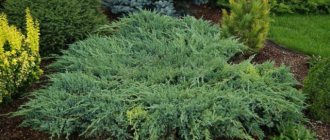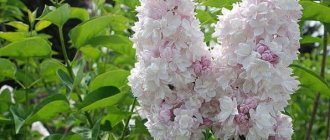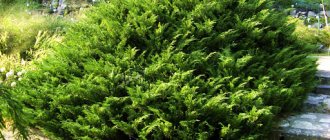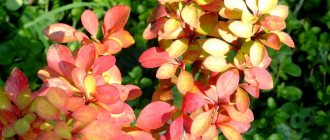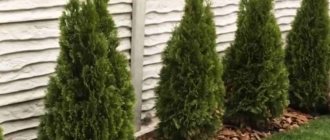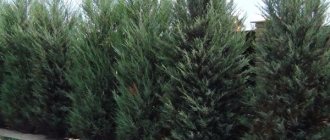Bushes and trees
0
326
Article rating
Kira Stoletova
Juniper Green Carpet (Juniperus communis Green Carpet) is a classic variety popular with gardeners. The origin of the shrub is American-Canadian, and its name translates as “Green Carpet.” The horizontally creeping plant really resembles a fluffy rug and looks very decorative.
Juniper Green Carpet - planting and care
Description of the plant
Green Carpet is a low-growing or dwarf variety. Its shoots branch well and intertwine, drooping towards the ground.
The average height of such a bush is 20 cm. It can grow larger, but this requires appropriate formation. The crown shape is cushion-shaped, diameter is about 2 m.
The needles are scaly and soft to the touch. In spring and summer it is bright green, in winter it darkens.
The cones are dark blue in color, with a waxy coating. They appear almost immediately and successfully complement the decorative appearance of the shrub.
Juniper is slow growing, its annual growth in width is 10-15 cm.
Growing regions
Due to its high frost resistance, this species can be grown throughout Russia. In the northern regions, juniper is insulated for the winter and covered with spruce branches.
When grown in the south, the plant needs more frequent watering, prevention of sunburn and protection from dry winds.
Description of the variety
Common juniper Green Carpet is an unpretentious plant that grows in areas with a temperate climate. The plant is highly resilient, can withstand Russian winters, and resists drought well. Suitable for growing in central Russia and its northern regions. Juniper prefers well-lit places, but can grow in partially shaded conditions. However, in this case, the color of the young needles will not be saturated.
A characteristic feature of the Green Carpet juniper is its dense creeping crown. The plant does not reach large sizes, grows slowly, by the age of ten its height does not exceed 20 cm. But juniper grows well in width, one bush grows up to 2 meters in diameter.
The short needles are needle-shaped and have sharp tips. Soft, bright green needles with a blue bloom densely cover the branches; over time, the needles darken. The bark of a young plant is red-brown in color, and with age it changes to a brown color.
A characteristic feature of the Green Carpet juniper is its dense creeping crown.
Description of Green Carpet:
- dense intertwined shoots;
- fruits in the form of numerous berries of a bluish tint with a bluish bloom;
- deep, unbranched root system;
- creeping ground cover form with a flat crown.
Juniper shoots intertwine with each other. The plant creates a flooring on the surface of the earth in the form of a carpet. This property is used in landscape design. Juniper is suitable for decorating rocky areas, alpine hills, and is used to strengthen slopes. Juniper evergreen lawns do not need to be cut or weeded. The plant is used for landscaping terraces and roofs.
Landing
When choosing a juniper seedling, you should give preference to a closed root system.
The shoots of a healthy plant are green and elastic, with the current year's growth. The bush should not have dry needles, dark or light spots, or any damage.
Landing location
Common juniper Green Carpet is not only a light-loving, but also a shade-tolerant plant. It does well in the sun (but not in direct sunlight) and in partial shade.
The shrub can grow in shade, but its crown will be less lush and the color will not be as bright. It prefers loose, moderately moist soils with an acidic reaction, but tolerates slightly alkaline soils well.
Landing technology
The plant needs sunlight
The planting hole is dug in advance (width - 2 times the earthen ball of the seedling, depth - 70 cm), pour a bucket of water into it and allow it to soak. Garden soil is combined with sand and peat in equal proportions.
When planting on dense soil, a drainage layer is required. It is made from broken clay bricks, sand or expanded clay.
The plant is placed in a hole and watered, and then covered with the prepared substrate, leaving the root collar at ground level.
Care
Juniper variety Green Carpet is unpretentious. An adult plant tolerates drought and frost well, without requiring constant attention and frequent watering. It needs only minimal care to grow, maintain its decorative appearance and prevent diseases.
Watering
Water the plant, focusing on the condition of the soil. In cool summers with frequent rainfall, it does not need watering at all, but in hot summers they are done weekly.
For an adult bush, use 10-12 liters of water. To preserve the beauty of the needles, sprinkling is carried out in the evenings.
Feeding
The shrub only needs one spring feeding with complex fertilizers for conifers. The granules are laid out in a circle near the trunk or dissolved in water and watered. After severe frosts, illnesses or other stresses, juniper can be sprayed with Epin.
Mulching and loosening
The crop requires loosening the soil and weeding from weeds only in the first season after planting. The same applies to mulching - sawdust, wood chips, peat or crushed bark can be poured into the tree trunk of a young plant.
When the crown grows into a dense carpet, the bush will not need any mulch or loosening.
Trimming
Sanitary pruning of shrubs is carried out every spring. At the same time, twigs, damaged and frozen shoots are removed.
Juniper tolerates shaping haircuts well: it is often cut on the sides to give the crown fullness and density.
Preparing for winter
Usually an adult plant tolerates winter well without shelter, but in a strong blizzard it can be covered with spruce branches. Young seedlings are covered with burlap or other materials, and the tree trunk circle is insulated with peat.
In early spring, when the sun is especially bright, it is advisable to shade the juniper to prevent it from burning out.
Common juniper Green Carpet: planting and care
Although we said that this variety is unpretentious in care, if you want your plant to develop properly, you need to take into account some nuances that are associated with the place where the juniper bush will grow:
- Sandy loam, sandy, calcareous soil is considered ideal for growing juniper.
- The acidity level of the soil should be somewhere between neutral and slightly acidic.
- It can tolerate shade quite well, but it is better to plant it in a well-lit area.
- Can be planted with plants that grow tall. But only if the shadow from a tall plant falls on the juniper for no more than 2 hours.
Juniper does not tolerate drafts and stagnant moisture. The Green Carpet variety is classified as a viable species. If the growing conditions are far from ideal, the plant may not die, but you should not expect development from it.
We prepare seedlings and planting area
In order for juniper growing to be successful, it is advisable to carry out a number of activities before planting. A good and correct seedling can only be purchased from a trusted nursery. For this reason, the roots are most often placed in a container with water, this will protect the roots from drying out. Before purchasing, you need to carefully examine the plant and needles so that they are not brittle or yellow in color. The chosen planting site must be dug up, collected various debris and weeds, and checked the degree of acidity of the soil. If necessary, carry out liming or acidification of the soil. Also, before planting, you need to prepare the material that will be needed for mulching.
Landing correctly
If the seedling has an open root system, then it is best to plant it in the spring, immediately after purchasing it. It is best to choose mid-April to the first half of May. If you do this later, there is a risk of sunburn. If you purchased planting material in a container, then plant it gently in the spring or in October. If you plant at a later period, there is a risk of freezing. Planting should look like this:
- If you are going to plant several bushes, then the places for planting holes should be marked in advance. If you want to get a continuous lawn, then you can plant the plants, maintaining a distance of about 1 m. In order to form separate spreading bushes, maintain a distance of up to 2 m.
- Lay drainage at the bottom of the hole in a layer of 10 cm (it is possible to use crushed stone, expanded clay, and white brick).
- Up to half the hole, you need to add a pre-prepared substrate, which contains: coarse sand, peat and soil that was collected from a coniferous forest.
- It will be nice if you can prepare the seats a little earlier. If this is done about 15 days before planting, the soil will be able to settle a little, which will reduce the risk of damage to the root system.
- During planting, the plant must be planted in the very center of the hole; using the prepared substrate, the root system must be lightly sprinkled.
due to the fact that the Green Carpet juniper does not really like frequent replanting, therefore the choice of place to grow the bush must be taken very carefully. After planting, it is necessary to water the plant very well and cover it with a layer of mulch. There is no need to wait that during growth, juniper can please you with its green shoots. If you notice that the plant does not change its color, then the plant was able to take root.
We water and apply fertilizers.
A plant that is completely rooted does not need special care. The watering and fertilizing regime is considered free. How to care for the plant:
- After planting, there is no need for watering or fertilizing for 1 month.
- During the first watering, you need to add 40 g of nitroammofoska (dose for each individual bush).
- Further watering will only be needed in the event of prolonged dry weather.
- In order for the needles to retain their beauty, it is necessary to spray them with a spray bottle approximately once every 10 days.
- You can apply fertilizer only once, using a special mixture for coniferous crops. It is best to fertilize in the spring in order to stimulate active plant growth.
We carry out the procedure of mulching and loosening.
Juniper of this variety is classified as a cover crop. Having reached adult growth, juniper does not need loosening at all or use a layer of mulch for protection. The branches of the bush are able to independently protect the soil from possible drying out, which in the future can lead to the formation of a crust. A young plant needs a little attention and care before the crown forms. the plant will also behave well. The plant is quite capable of tolerating soil cover using pine sawdust and coniferous bark. Using this method, you will be able to notice how the protective table should be no more than 5 cm.
We do cutting and shaping.
Like any other plant, juniper needs sanitary pruning. You need to remove all branches that are dry, damaged, or if there are traces of some disease or pest attack on the shoots. There is no need to leave the cut branches, they need to be taken outside your summer cottage and burned. To increase the growth of a bush, it is necessary to remove branches that are located along the edges, as well as limiting growth around the circumference. This way you can make the bush thick and it can grow in height, reaching about 30 cm.
We prepare the plant for the winter period.
The variety has good frost resistance. Can withstand frosts down to -40 degrees. The variety can withstand the cold of the central zone of our country well. Only a young bush, no more than 1 year old, needs to be covered. The soil near the bush needs to be mulched with a layer of about 10 cm. The planting can also be covered with lutrasil or special breathable agrofibre, and it needs to be pressed along the edges of the bush to the ground.
Reproduction
The most popular method is propagation by layering. The soil next to the bush is loosened, peat is added, fertilized and watered. The shoot from the parent bush is bent to the soil and secured.
Juniper can be propagated by layering
You can first clear the intended area of pine needles, make a shallow cut and sprinkle with Kornevin.
It takes 5-12 months before the roots appear. The branch is cut off and transplanted to a new location.
According to gardeners, Green Carpet takes root well, so this method is much better than cuttings or propagation by seeds.
Reproduction methods
Dioecious plants, which include junipers, are propagated by vegetative and seed methods. For the Green Carpet juniper variety, propagation methods by layering and cuttings are best suited. If you grow a bush using seeds, then the parental characteristics may not appear.
Classic options:
- By layering. The easiest way. It is enough to press the creeping shoot of the variety to the ground, water it occasionally, and after a year separate it from the mother plant. The seedlings easily adapt to a new location, but the typical crown shape will not be preserved in this case.
- By cuttings. In spring, cut material from short side shoots of juniper. Length 10 cm, always with a heel. First, the cuttings should be kept at a temperature of + 15-18 ° C, then increased to + 20 ° C. You can immediately plant it in a mother plant in an open garden bed.
Important! Juniper cuttings should be prepared before the buds awaken.
Diseases and pests
Green Carpet has high immunity, due to which it rarely gets sick. However, if it is over-moistened, it can be affected by fungi - fusarium, scute, rust.
To prevent infection, use Bordeaux mixture, Baktofit, Hom, Topsin. In case of damage, the diseased parts of the plant are removed, and healthy parts are treated with fungicides.
Aphids and scale insects can harm the bush. To combat them, the insecticides Confidor, Aktara, and Kallipso are used.
In spring, the larvae of the cockchafer, which eat the root system, are especially dangerous. Drugs based on diazonin and neonicotinoids are used against them.
Application in landscape design
The possibilities for using Green Carpet in landscape design are truly inexhaustible. Green lawns made from this juniper are widely popular - they look very decorative and require almost no maintenance.
- It is often grown as the lower tier of combined compositions and used in coniferous mixborders.
- The shrub perfectly strengthens slopes and slopes; it makes attractive living borders and pretty curtains.
- It looks very harmonious near ponds, among stones, in flower beds and rock gardens.
- It also goes well with junipers of other shades (blue, golden, lilac).
- Against its background, hydrangeas, spirea, viburnum, barberry and daylilies look beautiful.
In essence, the shrub perfectly enhances the beauty of any flowering plant.
With appropriate formation, this species can be grown in containers: such compositions are very impressive and are suitable for landscaping balconies, terraces, and small courtyards without planting land.
Juniper Green Carpet in landscape design
Ease of care, decorativeness all year round, and small annual growth make dwarf juniper popular with private gardeners and when decorating parks, squares, and public flower beds.
Designers especially value Green Carpet for its ability to create long-lasting, vibrant lawns that do not need to be mowed or weeded. The dense tangle of branches makes the germination of weeds impossible.
The height of the Green Carpet juniper can be modeled. Slightly taller bushes are formed from low-growing creeping plants using special pruning. In this case, the new growth rises above last year’s, and the bush takes on the appearance of wavy clumps. The needles of different years differ in color, so each “wave” is different from the previous one, which creates an amazing “layered” effect.
The root system of juniper lies shallow, grows strongly to the sides and is capable of holding together layers of soil. This property is used in landscape design to strengthen slopes and edges of ravines. Green Carpet, planted on an alpine hill, perfectly holds the entire structure together, keeping the artificial mounds from being washed away.
Dwarf juniper is most suitable for decorating rocky slopes and hills, and heather meadows. In flower beds and rock gardens, Green Carpet favorably sets off low flowering plants with small, bright buds. A good combination would be to plant phloxes, herbaceous cloves, and barberries against a background of juniper.
Often, plants with different shades of needles are planted side by side, creating original color transitions or highlighting crops in contrast. You can create an original cover environment from Green Carpet juniper for crops on a trunk. A good combination would be not only vertically developing conifers, but also deciduous or flowering bushes.
Reviews
Among the undeniable advantages of Green Carpet juniper, gardeners highlight decorativeness, stability and extremely easy care.
Slow growth and a beautiful natural shape allow you to limit yourself to only sanitary pruning, and thanks to the tightly intertwined branches, the continuous “carpet” is not afraid of weeds and there is no need for mulching.
Gardeners recommend planting currant bushes next to this coniferous plant - not only for beauty, but also to prevent rust.
Many summer residents note that shrub cuttings take root very well. According to some reviews, the shoot was simply pressed against the soil with a pebble and roots appeared on it within a year.
